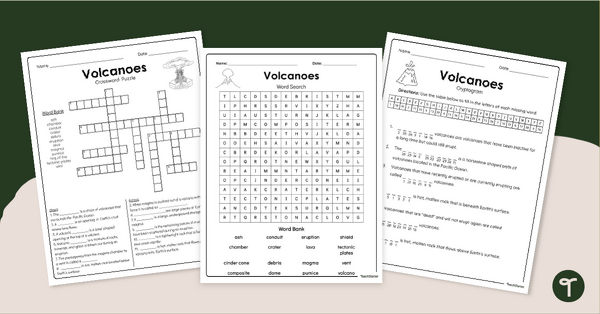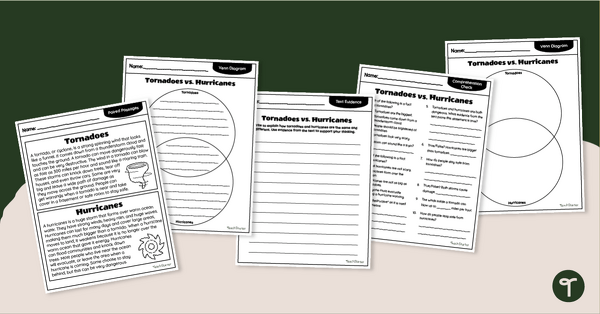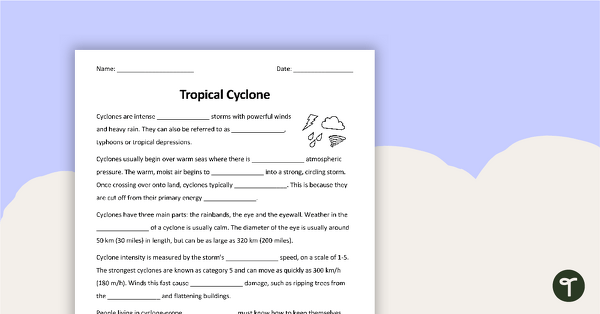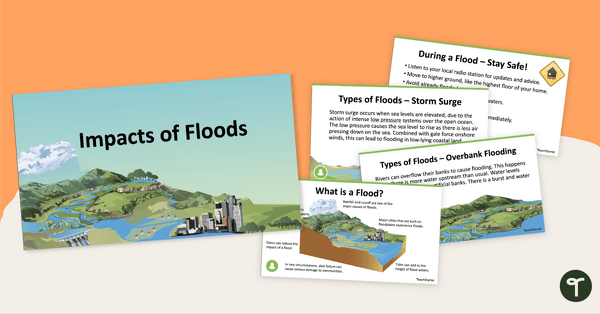Natural Disasters Teaching Resources
Explore natural disasters and their impact on our environment and society with printable worksheets, activities and more teaching resources created by teachers, for elementary teachers.
This collection of Earth science resources is aligned to the NGSS curriculum and includes vocabulary lists, comprehension passages and more. Each printable and digital resource has been carefully reviewed by a member of our teacher team to ensure it's ready to be used in your classroom!
Looking to better understand this part of the science curriculum, or just looking for fresh ideas to engage your students? Read on for a primer from our teacher team!
What Is a Natural Disaster? A Kid-Friendly Definition
Let's start with a definition for these events that you can use to describe this Earth science term to your students!
A natural disaster is an event caused by natural forces that result in significant damage, loss of life, or destruction.
The word "natural" is key in this definition because it clarifies that these events are beyond human control.
Types of Natural Disasters
Different natural disasters occur in different parts of the world and are the result of a variety of different conditions. In some parts of the US, hurricanes are more common, while other areas of the country are more prone to wildfires.
The types of natural disasters you talk about in your science class may come down to those that students are most likely to experience in their own backyards ... or maybe not. So let's take a look at the most common types that occur all around the world. along with some of the characteristics of each.
Hurricanes
- What It Is: A hurricane is a type of tropical storm with strong winds and heavy rain that can cause significant damage to coastal areas. Hurricanes form over warm ocean waters and can cause significant damage to coastal areas when they make landfall. In addition to high winds and rain, hurricanes can also cause storm surges, walls of water that can flood coastal areas.
- Where It Happens: Hurricanes are most common in the southeastern and Gulf Coast regions of the United States, including Florida, Louisiana, Texas and the Carolinas.
Tornadoes
- What It Is: A rotating column of air that can cause significant damage to buildings and structures is called a tornado. Tornadoes can uproot trees and power lines and destroy entire buildings. Tornadoes are typically very localized and can be difficult to predict, which makes them incredibly dangerous.
- Where It Happens: These can occur in many places in the United States but are most common in sections of the middle of the US known as "Tornado Alley." This part of the country includes parts of Texas, Oklahoma, Kansas, Nebraska and South Dakota.
Earthquakes
- What It Is: A sudden shaking of the ground caused by the movement of tectonic plates beneath the Earth's surface is known as an earthquake. Smaller tremors typically precede an earthquake, but they can be difficult to predict.
- Where It Happens: Earthquakes most commonly occur in the western United States, particularly along the Pacific coast, including California, Oregon and Washington.
Tsunamis
- What It Is: A tsunami is a series of ocean waves caused by an underwater earthquake, landslide or volcanic eruption that can cause significant damage to coastal areas. Tsunamis can cause significant damage to coastal areas — particularly in low-lying regions — and the people who live and work in affected areas are often advised to evacuate to higher ground or other designated safe areas.
- Where It Happens: While tsunamis can occur in any coastal region, the United States is most at risk for tsunamis in the Pacific Northwest region, including Alaska, Washington, Oregon, and Northern California.
Volcanoes
- What It Is: A volcano is an opening in the Earth's surface through which magma, ash, and gas can escape, sometimes leading to eruptions that can cause significant damage to nearby areas. When a volcano erupts, it can cause significant damage to nearby areas, and volcanic ash and other airborne particles can be spread by wind to places hundreds of miles away.
- Where It Happens: Volcanoes are most common in the western United States, particularly in Alaska and Hawaii. The Pacific Northwest region which includes Washington and Oregon, is also home to several active and potentially dangerous volcanoes.
Wildfires
- What It Is: Wildfires are uncontrolled fires in natural areas, such as forests or grasslands. They can be caused by lightning strikes, human activities or other natural causes, and can spread quickly, causing significant damage to vegetation, wildlife and people's homes and businesses.
- Where It Happens: Wildfires can occur in many regions of the United States, but they are most common in the western United States, particularly in California, Oregon and Washington.
Floods
- What It Is: Floods occur when water overflows or inundates land that is normally dry. They can be caused by heavy rain, snowmelt, storm surges, or other natural causes. In addition to causing damage through high water levels, floods can also create landslides and mudslides and carry debris and pollutants.
- Where It Happens: Flooding is most common in coastal regions of the United States as well as low-lying areas and regions with high levels of rainfall or snowmelt. The Gulf Coast, Florida, the Carolinas and the Midwest are all regions that are particularly prone to flooding.
- Free Plan

Free Volcano Worksheets
Download a set of free volcano worksheets to introduce your students to vocabulary and concepts related to volcanoes and volcanic disasters.
- Plus Plan

Earthquake - Tectonic Plates Geology Diagram & Worksheets
Introduce students to plate tectonics with a labeled diagram and worksheet set featuring different types of volcanoes, layers of earth and landforms.
- Plus Plan

Compare and Contrast - Tornadoes and Hurricanes Worksheet Pack
Compare and contrast tornadoes and hurricanes with a set of printable paired passage reading worksheets.
- Plus Plan

Slow & Fast Land Changes Worksheet - Cut and Paste
Use a Slow & Fast Land Changes worksheet to discover events that cause changes to the Earth’s surface.
- Free Plan

Natural Disasters Word Search
Use a Natural Disasters word search to introduce your students to the vocabulary surrounding these destructive acts of nature.
- Free Plan

Diagram of a Volcano - Labeling Worksheet
Label the diagram of a volcano with a printable volcano worksheet.
- Plus Plan

Hurricane Worksheets - Reading Response Activity Pack
Teach your 2nd graders about hurricanes with printable Hurricane Worksheets and constructed response activities.
- Plus Plan

Natural Disasters Game - Interactive
Play an interactive Natural Disasters Game to review the effects of natural disasters, such as tornadoes, tsunamis, hurricanes, earthquakes and volcanoes.
- Plus Plan

Earthquake Booklet for Kids - 2nd Grade
Explore earthquakes, their causes, effects, and how to prepare for them with a printable Earthquake booklet.
- Plus Plan

Severe Weather STEM - Build a Storm Shelter Project
Design a storm shelter to protect against wind and rain with a hands-on Weather Stem Challenge.
- Plus Plan

Informative Text Writing Task – Why Do Volcanoes Erupt?
Research and write about how volcanoes erupt with a scaffolded informational writing task.
- Plus Plan

Natural Disasters - Flood Simulation Experiment
A hands-on experiment to use when exploring natural disasters.
- Plus Plan

Natural Disasters – Instructional Slide Deck
Investigate rapid changes to Earth's surface and other natural disasters such as volcanic eruptions, earthquakes, and landslides with this instructional slide deck.
- Plus Plan

4th Grade Writing Worksheets: Tornado Text-Based Writing
Enhance your students' comprehension, vocabulary, and writing skills using 4th Grade writing worksheets and a high-interest reading passage about Tornadoes.
- Plus Plan

Tropical Cyclone Cloze Worksheet
A cloze worksheet about tropical cyclones.
- Plus Plan

Natural Disaster Posters With Information
Introduce and explain different types of natural disasters with printable natural disaster posters.
- Plus Plan

Natural Disasters Project
Assign a natural disaster project to engage your students in researching and creating a natural disaster poster about a historical event.
- Plus Plan

Tornado in a Jar Science Experiment
Create a Tornado in a Jar with an interactive science experiment slide deck and Tornado in a Jar Science Experiment Worksheets.
- Plus Plan

2nd Grade Hurricane Worksheets - Reading Comprehension
Read and learn about hurricanes with our 2nd Grade Hurricane Worksheets resource pack.
- Plus Plan

Natural Disasters – Printable Puzzles for 3rd Grade & 2nd Grade
Match pictures and facts of various natural disasters with this set of printable science puzzles.
- Plus Plan

Impacts of Floods PowerPoint
An editable PowerPoint teaching resource about floods and their impact on our communities.
- Free Plan

Natural Disasters – Vocabulary Cards
Reinforce science vocabulary in your classroom with this set of free word wall cards that focus on natural disasters.
- Plus Plan

Natural Disasters – Poster Pack
Display information about different types of natural disasters with this poster pack.
- Plus Plan

Earthquake Word Wall Vocabulary
34 earthquake related vocabulary cards for a word wall.
- Plus Plan

Natural Disasters Word Wall Vocabulary
Use this teacher-created resource to explore natural disaster vocabulary with your elementary students.
- Plus Plan

Flood Vocabulary Worksheet
A vocabulary task for students to use when learning about floods.
- Plus Plan

Flood Safety Poster Activity
An activity for students to demonstrate their understanding of the impact of floods.